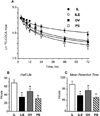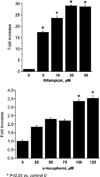Vitamin E in New-Generation Lipid Emulsions Protects Against Parenteral Nutrition-Associated Liver Disease in Parenteral Nutrition-Fed Preterm Pigs
- PMID: 25596209
- PMCID: PMC4504844
- DOI: 10.1177/0148607114567900
Vitamin E in New-Generation Lipid Emulsions Protects Against Parenteral Nutrition-Associated Liver Disease in Parenteral Nutrition-Fed Preterm Pigs
Abstract
Introduction: Parenteral nutrition (PN) in preterm infants leads to PN-associated liver disease (PNALD). PNALD has been linked to serum accumulation of phytosterols that are abundant in plant oil but absent in fish oil emulsions.
Hypothesis: Whether modifying the phytosterol and vitamin E composition of soy and fish oil lipid emulsions affects development of PNALD in preterm pigs.
Methods: We measured markers of PNALD in preterm pigs that received 14 days of PN that included 1 of the following: (1) Intralipid (IL, 100% soybean oil), (2) Intralipid + vitamin E (ILE, d-α-tocopherol), (3) Omegaven (OV, 100% fish oil), or (4) Omegaven + phytosterols (PS, β-sitosterol, campesterol, and stigmasterol).
Results: Serum levels of direct bilirubin, gamma glutamyl transferase, serum triglyceride, low-density lipoprotein, and hepatic triglyceride content were significantly lower (P < .05) in the ILE, OV, and PS compared to IL. Hepatic cholesterol 7-hydroxylase and organic solute transporter-α expression was lower (P < .05) and portal plasma FGF19 higher in the ILE, OV, and PS vs IL. Hepatic expression of mitochondrial carnitine palmitoyltransferase 1A and microsomal cytochrome P450 2E1 fatty acid oxidation genes was higher in ILE, OV, and PS vs IL. In vivo (13)C-CDCA clearance and expression of pregnane X receptor target genes, cytochrome P450 3A29 and multidrug resistance-associated protein 2, were higher in ILE, OV, and PS vs IL.
Conclusions: α-tocopherol in Omegaven and added to Intralipid prevented serum and liver increases in biliary and lipidemic markers of PNALD in preterm piglets. The addition of phytosterols to Omegaven did not produce evidence of PNALD.
Keywords: cholestasis; life cycle; liver disease; neonates; nuclear receptors; phytosterols; research and diseases.
© 2015 American Society for Parenteral and Enteral Nutrition.
Figures









Similar articles
-
New generation lipid emulsions prevent PNALD in chronic parenterally fed preterm pigs.J Lipid Res. 2014 Mar;55(3):466-77. doi: 10.1194/jlr.M044545. Epub 2014 Jan 29. J Lipid Res. 2014. PMID: 24478031 Free PMC article.
-
Rifampicin, not vitamin E, suppresses parenteral nutrition-associated liver disease development through the pregnane X receptor pathway in piglets.Am J Physiol Gastrointest Liver Physiol. 2020 Jan 1;318(1):G41-G52. doi: 10.1152/ajpgi.00193.2019. Epub 2019 Oct 11. Am J Physiol Gastrointest Liver Physiol. 2020. PMID: 31604032 Free PMC article.
-
Lipid emulsions for parenterally fed term and late preterm infants.Cochrane Database Syst Rev. 2019 Jun 4;6(6):CD013171. doi: 10.1002/14651858.CD013171.pub2. Cochrane Database Syst Rev. 2019. PMID: 31158920 Free PMC article.
-
Depletion and enrichment of phytosterols in soybean oil lipid emulsions directly associate with serum markers of cholestasis in preterm parenteral nutrition-fed pigs.JPEN J Parenter Enteral Nutr. 2022 Jan;46(1):160-171. doi: 10.1002/jpen.2088. Epub 2021 Apr 30. JPEN J Parenter Enteral Nutr. 2022. PMID: 33581699 Free PMC article.
-
Impact of new-generation lipid emulsions on cellular mechanisms of parenteral nutrition-associated liver disease.Adv Nutr. 2014 Jan 1;5(1):82-91. doi: 10.3945/an.113.004796. Adv Nutr. 2014. PMID: 24425726 Free PMC article. Review.
Cited by
-
Alpha-tocopherol in intravenous lipid emulsions imparts hepatic protection in a murine model of hepatosteatosis induced by the enteral administration of a parenteral nutrition solution.PLoS One. 2019 Jul 11;14(7):e0217155. doi: 10.1371/journal.pone.0217155. eCollection 2019. PLoS One. 2019. PMID: 31295333 Free PMC article.
-
Fish Oil Emulsion Reduces Liver Injury and Liver Transplantation in Children with Intestinal Failure-Associated Liver Disease: A Multicenter Integrated Study.J Pediatr. 2021 Mar;230:46-54.e2. doi: 10.1016/j.jpeds.2020.09.068. Epub 2020 Oct 8. J Pediatr. 2021. PMID: 33038344 Free PMC article.
-
Association between multioil intravenous lipid emulsion and cholestasis in infants with gastrointestinal disorders: A retrospective cohort study.JPEN J Parenter Enteral Nutr. 2025 Aug;49(6):707-716. doi: 10.1002/jpen.2776. Epub 2025 Jun 3. JPEN J Parenter Enteral Nutr. 2025. PMID: 40462537 Free PMC article.
-
Selective Agonism of Liver and Gut FXR Prevents Cholestasis and Intestinal Atrophy in Parenterally Fed Neonatal Pigs.bioRxiv [Preprint]. 2024 Sep 7:2024.09.03.611073. doi: 10.1101/2024.09.03.611073. bioRxiv. 2024. PMID: 39282416 Free PMC article. Preprint.
-
Controversies in the Mechanism of Total Parenteral Nutrition Induced Pathology.Children (Basel). 2015 Jul 31;2(3):358-70. doi: 10.3390/children2030358. Children (Basel). 2015. PMID: 27417369 Free PMC article. Review.
References
-
- Carter BA, Karpen SJ. Intestinal failure-associated liver disease: management and treatment strategies past, present, and future. Semin Liver Dis. 2007;27:251–258. - PubMed
-
- Christensen RD, Henry E, Wiedmeier SE, Burnett J, Lambert DK. Identifying patients, on the first day of life, at high-risk of developing parenteral nutrition-associated liver disease. J Perinatol. 2007;27:284–290. - PubMed
-
- Carter BA, Shulman RJ. Mechanisms of disease: update on the molecular etiology and fundamentals of parenteral nutrition associated cholestasis. Nat Clin Pract Gastroenterol Hepatol. 2007;4:277–287. - PubMed
-
- Waitzberg DL, Torrinhas RS. Fish oil lipid emulsions and immune response: what clinicians need to know. Nutr Clin Pract. 2009;24:487–499. - PubMed
Publication types
MeSH terms
Substances
Grants and funding
LinkOut - more resources
Full Text Sources
Other Literature Sources
Medical

